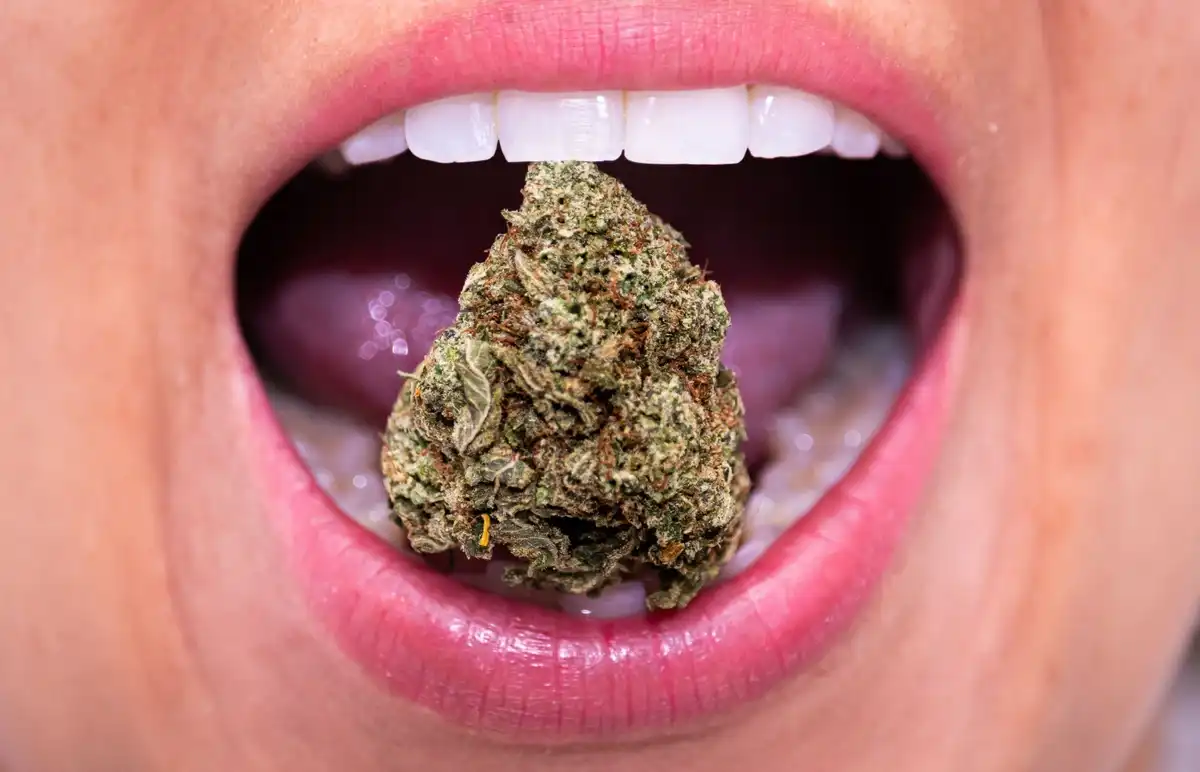Does Smoking Weed Affect Your Gums And Teeth?


Now that marijuana is legal in so many places—and the stigma of using it both recreationally and medicinally isn’t what it used to be—we’re seeing a lot more people smoke or vape cannabis. And yes, your dentist and hygienist can tell when you’ve been smoking marijuana. But how does weed affect your teeth, gums, or your oral health overall? Are “weed teeth” really a thing?!
How Does Smoking Affect Your Teeth
Marijuana aside, all types of smoking can impact your mouth and overall oral health. It’s not just marijuana and nicotine. First off, smoking anything will cause changes in your oral tissues. We tend to see your gums dry out more, not to mention heavy stains (particularly behind your upper front teeth, where the marijuana smoke hits your mouth first.) Plus, there’s usually an uptick in more precancerous and cancerous tissues. All of the chemicals and hot temperatures, day after day, gradually take a toll on your mouth at the cellular level. But with weed, teeth and gum tissues respond a little bit differently than they do traditional cigarette smoking.
THC Effect On Teeth & Oral Health
Effects of Marijuana Smoke or Vape
One of the reasons why so many people vape is because they’ve been led to believe that it’s safer or healthier than traditional smoking or other nicotine products. What we’ve seen in dentistry is that both are equally damaging to people’s mouths. For some, there may be an uptick in cavities. For others, it could be more aggressive gum disease. One condition isn’t necessarily “worse” than the other; they’re both bad and they both have long-term implications.
Whether your smoking tobacco, smoking marijuana or vaping it, you’re going to see similar side-effects like:
- Green or black stain on teeth
- Dry mouth
- Higher risk of gum disease
- More cavities (especially with cannabis)
- Increased risk of tooth loss
- Bad breath
- Precancerous tissues and oral cancer
- Oral burns
- Suppresses the immune system
A lot of vaping products also contain added flavors and sweeteners. When you inhale them, they coat the teeth and “feed” the bacteria responsible for causing cavities. If you’re using vaping as a healthy way to break a smoking habit, it’s not as healthy as what you might actually think it is.
Increased Snacking = More Cavities
Cannabis users snack more often than non-marijuana users. And because of the types of foods and drinks they crave, they tend to have a significantly higher rate of cavities throughout their mouth. And not just in the typical cavity-prone areas like between back teeth or in the deep pits/grooves of their molars. We also see smooth-surface cavities throughout their mouth, which is not a typical pattern for tooth decay. If someone is visiting the dentist for a checkup and we see lots of smooth areas with tooth decay in them, we know that something else is going on in the background. As a reminder, every time we eat or drink something, those food particles allow our normal oral bacteria to secrete acids for the next half hour. More frequent snacking means more acid, which means more cavities and tooth decay.
Then, there’s the fact that smoking cannabis tends to dry out saliva and contribute to xerostomia (dry mouth.) Even without the nutritional risk factors, xerostomia automatically puts people at a higher risk of tooth decay and getting cavities. When you have the two together, it’s a classic recipe for tooth decay.
Increased Risk Of Gum Disease
We often see an increase in periodontal infections in people who smoke cigarettes. Especially since their smoking habit limits inflammation and bleeding, masking the most common warning signs of gum disease. It might be similar to using cannabis. Especially if you’re snacking more often and not removing plaque as thoroughly or frequently as you need to.
On a related note, cannabis can also work as an immunosuppressant, which may be why some people are more prone to infections like gum disease if they use marijuana regularly.
Increased Risk Of Tooth Loss
Periodontal disease is the #1 cause of tooth loss for most adults in the United States. And since we know smoking marijuana can raise your risk of periodontal disease, it by nature also increases your chances of tooth loss and negatively impact oral health.
As gum disease progresses, it can lead to gum recession and bone shrinkage, along with tooth mobility. If you seem to be getting “long in the tooth” for no apparent reason, the weed might be to blame.
Fortunately, there’s good news. If your dentist and hygienist provide you with gum disease therapy and dental care early on—and you re-vamp your oral hygiene routine—you can help halt the tissue deterioration before you lose your teeth. You can protect your oral health by practicing good oral hygiene and limiting marijuana use. Just keep in mind that smoking delays tissue healing. People who continually smoke marijuana will likely fail to see less of an improvement in their oral health, even after professional dental treatment.
Increased Risk Of Oral And Neck Cancer
Warning signs of oral cancer typically include sores that don’t heal or tissues that appear different from the identical area on the opposite side of your mouth. This can also include lumps or nodules.
Since oral cancer can be extremely difficult to pinpoint on your own, it’s very important to let your dental team know that you use cannabis and to schedule regular checkups with oral cancer screenings at least twice a year. Oral cancer is best treated through early intervention, so your routine exam and cleaning appointment could technically save your life.
Can Dentist Tell If You Smoke Weed…YES!
If you think smoking weed is “less bad” on your teeth than smoking or vaping other things, think again. People who use marijuana on a regular basis are statistically much, much, much more likely to experience lots of cavities not to mention periodontal disease at an earlier age. Plus, an increased risk of oral cancer. And then there’s the tooth stain, but at least that can be polished off! Regular marijuana users need to understand how recreational or medicinal use over a prolonged basis can permanently destroy their smiles. If you do use marijuana, be sure to let your dental team know so that they can help you take steps to protect your smile. That’s their job!

Make your inbox smile!
Subscribe






